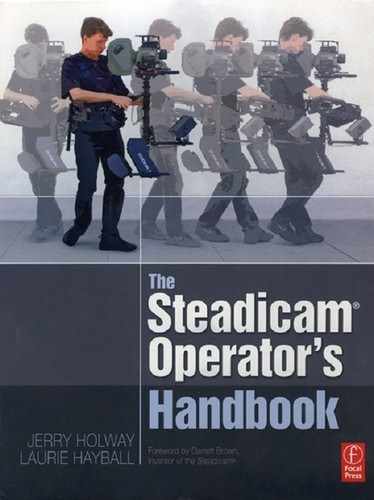The emotional stuff
One of the things we always try to do is find some emotional connection to what is happening in the story and somehow have that influence our operating. Sometimes this connection is pretty thin, and not much shows up in the shot. Making an emotional connection to the story helps with remembering what the story is and therefore, at a minimum, knowing what should be in frame.

In Dreams 1:27:33
At other times the emotional connection to the story is strong, but the exact effect on the image is subtle. A case in point: Late in the film In Dreams, Claire Cooper (Annette Bening) is being chased by Vivian Thompson (Robert Downey Jr.) up into a loft in the barn full of rotting apples. The situation is a bit complicated by the fact that she is not only being chased but she is leading this psychotic killer away from a little girl.
The shot starts looking through Claire's legs down the stairs. Read what you like into that. Vivian enters frame and the camera catches a line of his dialogue and a glimpse of him coming up the stairs. Then the camera rapidly tilts up, pans left, and backs away to sharply reveal Claire trapped in the loft and, an instant later, Vivian popping into frame. The sharpness of the camera's move was discussed on set; the first take was a safer, slower move, and it was really dull and uninvolving. We actually used the word “sharp” to describe how the camera should move, but no one discussed the sharpness of the actors' movements.
The next part of the shot is a straight backward tracking shot that continues until there is a walkway to the left of frame leading to a silo. The emotional image in my mind at that point was that Claire is trapped, and thframe is her cage. Therefore the camera only pans if Claire bangs up against the frame and forces it over. Several times during the walk back she approaches the left edge of the frame, but the camera refuses to reframe. The frame becomes part of her trap.
Even during the pan, Claire has to push the frame several times to enter the new space.
The connection between my operating and the story is clear in my mind Everyone responds to the “tightness” of this approach, yet nothing about it is ever said on set, nor is the effect glaring or obtrusive on the screen.
The next section of the shot is rather curious, as Vivian is no longer in frame. Are we in a POV shot? It's not the classic “passing over the shoulder and becoming a POV” trick. The situation is not clear. The camera sort of takes a beat and lets Claire get away. Now the camera is really where the audience knows Vivian should be, but he doesn't enter the frame. Are we in a POV now? Where is the killer?
The camera charges Claire as if it were Vivian's POV, but at the last instant the camera flies by her and tilts radically down to reveal her POV of the empty silo. It's an extremely visceral move at the end of a curious and unsettling shot. It felt pretty good after the eleventh take — that last move was a killer.
Making an emotional connection helps to:
- Create specific frames and moves
- Remember the story
- Improve your work
